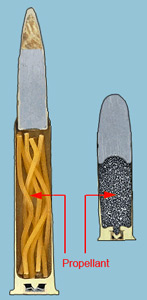Home | Glossary | Resources | Help | Contact Us | Course Map
Archival Notice
This is an archive page that is no longer being updated. It may contain outdated information and links may no longer function as originally intended.
Propellants
Modern small arms propellants all share a common origin, nitrocellulose. Nitrocellulose carries the majority of the chemical energy used to propel a projectile from a gun barrel. It is the result of treating cellulose with nitric acid in the presence of sulfuric acid.
For decades, the preferred source of cellulose was cotton linters, a by-product of the processing of cotton. As synthetic fibers reduced the amount of cotton by-products produced, finely ground wood fibers replaced linters in nitrocellulose production.
The first step in propellant manufacture is to create a mass of nitrocellulose (cellulose nitrate). Linters or wood fibers are exposed to nitric acid; nitrate radicals replace some of the hydrogen molecules in cellulose, adding oxygen and energy to the reaction. To achieve the proper level of nitration, sulfuric acid is included to scavenge excess water so the maximum number of nitrate radicals can attach and preclude the reaction from coming to a halt.
The resulting mass of nitrocellulose must be sticky and relatively cohesive for further processing; a solvent must be incorporated into the mass to achieve these properties. Only certain chemicals act as nitrocellulose solvents. For single-base propellants, the mass is softened with a mixture of alcohol and ether, which adds practically no energy to the nitrocellulose.
For double-based propellants, nitroglycerin (NG) is used as a solvent. NG adds significant energy of its own, supplementing the nitrocellulose contribution. Although pure nitroglycerin is very dangerous to handle, mixing it with other materials, including nitrocellulose, controls its explosive nature.
Double-base propellants have a slight advantage over single-base varieties: NG is not very volatile, and therefore is very stable over time. The alcohol-ether solvent in single-base propellants is very volatile, and evaporation of the solvent can change the rate at which the propellant releases energy. Modern packaging and storage techniques have eliminated this problem. Materials like the alcohol-ether blend or NG are called plasticizers, and are mandatory for the way the nitrocellulose is subsequently processed. Once the nitrocellulose mass is made cohesive by the plasticizers, it is ready for the next step extrusion. Before understanding extrusion, we need to understand the common shapes used in modern propellants.
Additional Online Courses
- What Every First Responding Officer Should Know About DNA Evidence
- Collecting DNA Evidence at Property Crime Scenes
- DNA – A Prosecutor’s Practice Notebook
- Crime Scene and DNA Basics
- Laboratory Safety Programs
- DNA Amplification
- Population Genetics and Statistics
- Non-STR DNA Markers: SNPs, Y-STRs, LCN and mtDNA
- Firearms Examiner Training
- Forensic DNA Education for Law Enforcement Decisionmakers
- What Every Investigator and Evidence Technician Should Know About DNA Evidence
- Principles of Forensic DNA for Officers of the Court
- Law 101: Legal Guide for the Forensic Expert
- Laboratory Orientation and Testing of Body Fluids and Tissues
- DNA Extraction and Quantitation
- STR Data Analysis and Interpretation
- Communication Skills, Report Writing, and Courtroom Testimony
- Español for Law Enforcement
- Amplified DNA Product Separation for Forensic Analysts


